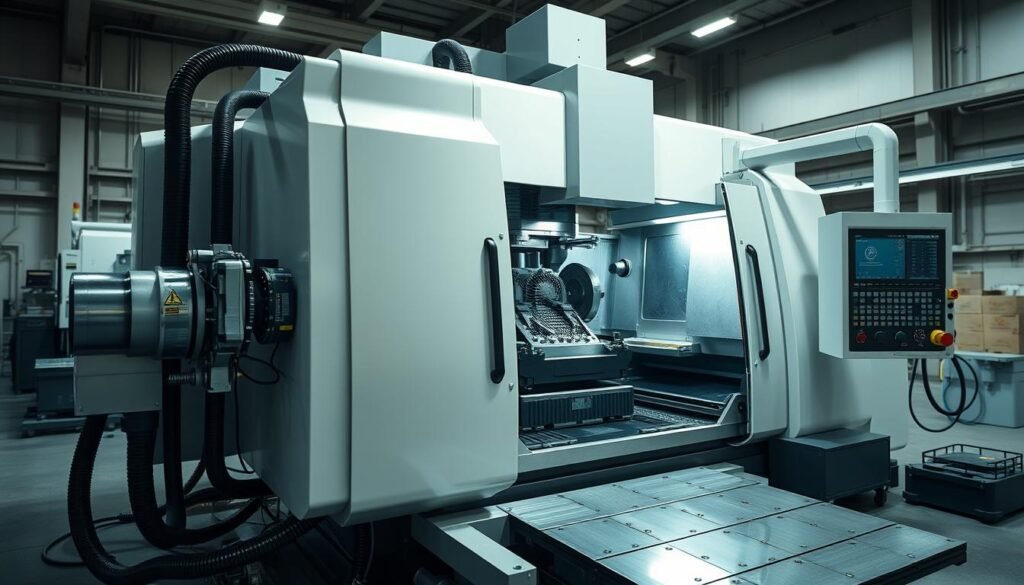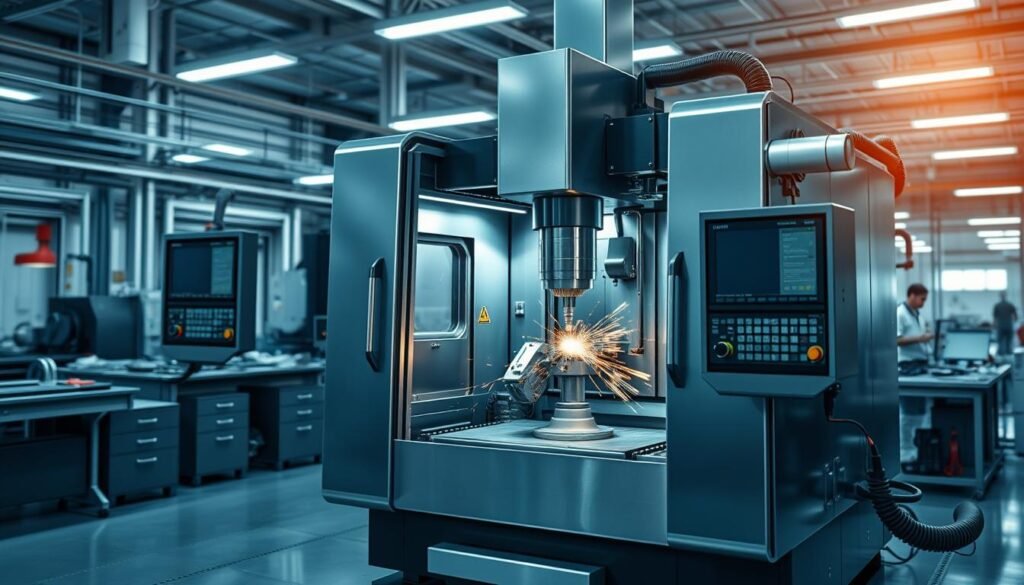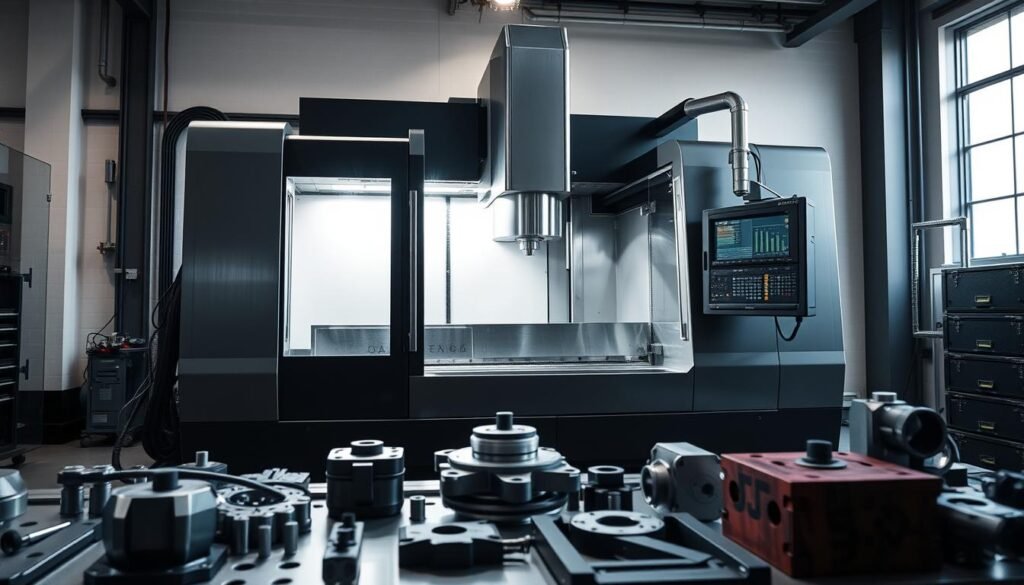The 5-axis CNC machine represents a breakthrough in computer-controlled manufacturing. This highly precise technology enables complex machining processes that traditional CNC machines cannot handle.
At its core, a 5-axis CNC machine differs from conventional systems by its ability to machine workpieces simultaneously on five different axes. This innovation allows for more precise and efficient manufacturing processes across various industries.
CNC technology has rapidly evolved since its inception. Modern 5-axis CNC machines offer manufacturing companies unparalleled flexibility and accuracy in producing complex components.
Key findings
- Five simultaneous axes of movement enable complex machining operations.
- Higher precision than traditional CNC machines.
- Revolutionary technology for modern manufacturing processes.
- Reduction of setup times and tool changes.
- Applicable in aerospace, medical technology, and mechanical engineering.
Definition of a 5-axis CNC machine.
A 5-axis CNC machine is a highly precise machining system that enables complex manufacturing processes. Unlike traditional 3-axis machines, this technology has two additional rotational axes, allowing for precise machining of workpieces from different angles.

The rotation axes expand the possibilities of linear movements and enable simultaneous processing that was not possible before. The five axes are composed as follows:
- Three linear axes: X, Y, Z
- Two rotation axes: A, B, or C
There are different configurations of 5-axis machines:
| Configuration type | Description |
|---|---|
| Tisch-Tisch-Kinematik | Both rotation axes are located on the worktable |
| Kopf-Kopf-Kinematik | Rotation axes are mounted on the tool head and machine head |
| Tisch-Kopf-Kinematik | Combined rotation of the table and tool head |
Simultaneous processing fundamentally differs from 3+2-axis machining. While in 3+2 axis systems the rotation occurs separately, in true 5-axis machines all axes operate simultaneously. This enables significantly more efficient and precise manufacturing of complex geometries.
Main features of a 5-axis machine
5-axis CNC machines revolutionize modern precision manufacturing with their unique capabilities. These advanced technologies enable unparalleled flexibility and accuracy in workpiece machining.
Simultaneous movement of axes
Multi-axis machining is the core of 5-axis technology. By being able to move all five axes simultaneously, complex machining paths can be realized with the highest precision. This approach significantly reduces machining times and increases efficiency.
Machining complex geometries
In terms of workpiece geometry, 5-axis machines offer unmatched possibilities. They can precisely contour and shape demanding forms that would be impossible with traditional methods. Examples include:
- Turbine blades with complex profiles
- Medical implants with precise surface structures
- Aerospace components with intricate geometries
Reduced workpiece stresses
A significant strength of these machines lies in minimizing workpiece stresses. By enabling parts to be machined from different angles, setup times are significantly reduced and precision is increased.
Improved accuracy and surface quality
Optimized tool alignment and constant cutting conditions lead to an outstanding surface quality. Precision manufacturing sets new standards here, with tolerances that are barely measurable and surface structures that meet the highest quality requirements.
Applications of 5-axis CNC machines

5-axis CNC machines revolutionize modern manufacturing technology through their versatile applications in various industries. These precise manufacturing systems play a crucial role in highly complex production processes.
In aerospace, 5-axis CNC machines enable the production of highly precise turbine blades and complex structural components. The ability to machine multi-dimensional surfaces makes them essential for the development of modern aircraft.
The automotive industry uses this technology for the production of:
- Precise engine components
- Complex body shapes
- Hochleistungs-Antriebssystemen
In the field of medical technology, 5-axis CNC machines enable the manufacturing of:
- Custom implants
- Surgical precision instruments
- Complex medical components
Tool and mold making also benefits from this technology. Complex injection molds and high-precision stamping tools can now be produced with unprecedented accuracy.
The flexibility and precision of 5-axis CNC machines make them a key element of modern manufacturing technologies.
Conclusion on 5-axis CNC technology
The 5-axis CNC technology marks a decisive turning point in the future of manufacturing. Companies that implement this innovative technology position themselves at the forefront of industrial development and drive digitalization in the production landscape.
In the context of Industry 4.0, 5-axis CNC machines enable a more precise and flexible manufacturing environment. They reduce production times, increase efficiency, and allow the production of complex geometries that would not be achievable with traditional methods.
The technological integration of artificial intelligence and machine learning into CNC systems will further revolutionize the performance of these machines. Companies that invest early in these technologies secure a decisive competitive advantage in an increasingly digitalized manufacturing world.
In summary, 5-axis CNC technology not only represents a technological advancement but also a strategic approach to optimizing industrial manufacturing processes in a rapidly changing global economic landscape.


